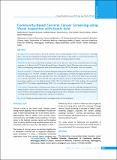Please use this identifier to cite or link to this item:
https://hdl.handle.net/20.500.14356/913| Title: | Community-Based Cervical Cancer Screening using Visual Inspection with Acetic Acid |
| Authors: | Mulmi, Rashmi Shrestha, Gambhir Pathak, Ayodhya Sharma, Manju Dawadi, Tara Siwakoti, Bhola Pradhananga, Kishore Kumar |
| Citation: | MulmiR., ShresthaG., PathakA., SharmaM., DawadiT., SiwakotiB., & PradhanangaK. K. (2022). Community-Based Cervical Cancer Screening using Visual Inspection with Acetic Acid. Journal of Nepal Health Research Council, 20(02), 499-504. https://doi.org/10.33314/jnhrc.v20i02.4021 |
| Issue Date: | 2022 |
| Publisher: | Nepal Health Research Council |
| Keywords: | Nepal Prevention and control Screening Uterine cervical neoplasms |
| Series/Report no.: | April-June, 2022;4021 |
| Abstract: | Abstract Background: Cervical cancer is the most common cancer among Nepalese women. Cervical cancer screening plays a vital role in reducing the morbidity and mortality of the disease. In this study, we assessed the prevalence of precancerous lesions of cervical cancer from community-based screening programs in Nepal. Methods: In this cross-sectional study involving record review, data were drawn from community-based screening programs in 14 districts by B.P. Koirala Memorial Cancer Hospital in Nepal. All women who underwent cervical cancer screening using visual inspection with acetic acid between June 2017 to December 2018 were included. Results: A total of 7,270 women were screened during the study period with the prevalence of cervical precancerous lesions among 153 (2.1%; 95% Confidence Interval 1.8-2.5) participants. Of which, the highest positivity rate was observed in the age group 30 years and below (46, 3%). The majority (4453, 61%) of the total women screened, were married at age below 20 years and 188 (3%) reported a history of cancer in their families. The most common presenting complaints were low abdominal pain (1236, 17%), low back pain (1152, 16%), itching in the anogenital region (828, 11%), and per vaginal discharge (818, 11%). Cervical cancer was suspected in 25 (0.3%) women. Conclusions: The prevalence of precancerous lesions of cervical cancer is low but with high existing risk factors among Nepalese women of selected districts. The government should implement effective and sustained cervical cancer awareness and population-based screening programs along with a continuum of care. The national criteria for screening should also include young women with known risk factors. Keywords: Nepal; prevention and control; screening; uterine cervical neoplasms |
| Description: | Original Article |
| URI: | http://103.69.126.140:8080/handle/20.500.14356/913 |
| ISSN: | Print ISSN: 1727-5482; Online ISSN: 1999-6217 |
| Appears in Collections: | Vol 20 No 02 Issue 55 April-June, 2022 |
Files in This Item:
| File | Description | Size | Format | |
|---|---|---|---|---|
| 4021-Manuscript-29705-1-10-20221103.pdf | Full Article. | 327.28 kB | Adobe PDF |  View/Open |
Items in DSpace are protected by copyright, with all rights reserved, unless otherwise indicated.
